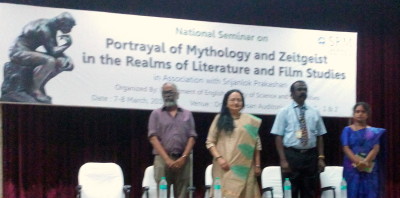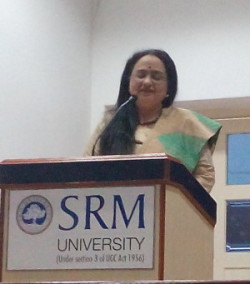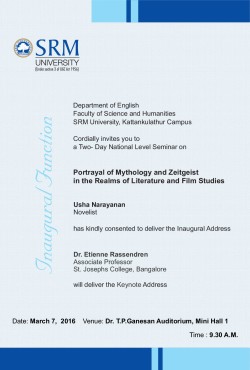My Speech on Myth & the Zeitgeist at SRM University
SRM is one of India’s top ranking universities, offering a gamut of programs, many in collaboration with global leaders in education, and it is a privilege to be here today. I am delighted to have been invited to deliver the inaugural address of the SRM University National Seminar on Portrayal of Mythology and the Zeitgeist in the Realms of Literature and Film Studies.
By a happy coincidence, tonight is Maha Shivratri, sacred to Shiva, about whom we have heard so many stories. A good day to inaugurate this seminar, don’t you think? Or perhaps it is not such a rare coincidence. After all, we have many sacred days throughout the year. We have sacred trees and flowers, animals and birds that serve as vehicles of the gods. So many festivals, and of course, the delicacies that go with them! We say that Ganesha likes modakas; that Krishna likes butter. We offer Hanuman garlands made of vadas. And then, we eat them all! Our ancestors, as well as those of other ancient cultures, have integrated nature, food and all creation with our lives ― through the power of myth.
Mythology. The word refers to sacred tales or fables of a culture, narrating stories of gods and demons, superheroes and sorcerers, curses and prophecies. Myths delve into ancient beliefs on good and evil, life and death, and are filled with vibrant tales of romance, adventure, divinity and magic. As with any other story, a myth too reflects the times in which it is set.
Zeitgeist is defined as the general intellectual, moral and cultural climate of an era; or the ideas and spirit of a particular time and place.
What better way to start than with a story from our puranas? Once, the asura Vritra imprisoned the waters of the universe, causing drought and death in the three realms. An enraged Lord Indra killed the asura with his thunderbolt, thereby earning the gratitude of all living beings as well as the throne of the King of Heavens. The adulation he received made him vain and he asked the divine architect Vishvakarma to build him a grand palace worthy of his stature. Vishvakarma began the task happily enough and created an abode more splendid than any that the gods had seen before. But Indra was not happy. ‘Bigger, grander, more ornate!’ he demanded. Vishvakarma began his task once more and built a breathtaking mansion. But Indra was still not satisfied. And then a handsome, dark-skinned boy appeared at the palace doors. He told Indra that he had come to see if his palace was better than those of previous Indras. ‘Previous Indras?’ echoed the king of the devas. ‘Yes, there have been many Indras before you and many more will follow,’ said the boy. ‘Look at the row of ants that is entering your mansion. Each of them was an Indra before pride vanquished him.’ Indra was shocked, humbled and repentant.
Who do you think that boy was? None other than Lord Vishnu, come to teach Indra a lesson, to make him introspect and ponder over the nature of life.
How would you interpret this story? It could be a parable on the folly of arrogance or on the ephemeral nature of wealth and power. Or it could be an illustration of the cyclical nature of life that is a common belief in many ancient religions. ‘What has been will be again, what has been done will be done again; there is nothing new under the sun,’ says the Hebrew Bible. ‘You and I have passed through many births, Arjuna. You have forgotten, but I remember them all,’ says Krishna.
What is the true meaning then? The answer could encompass all these interpretations, for that is the nature and the beauty of myth.
Myths through the yugas
Hindu philosophy says that there are four yugas or cycles of time. In the first age of Satya, the world stands firmly on the four legs of dharma. In the second age of Treta, sin destroys one leg, and in Dwapara, a second leg. When Kali dawns, a third leg is destroyed and only one fourth of virtue remains.
The Ramayana is set in the Treta Yuga, when people adhered to the law. Lord Rama personified the ideal man and ruler, upholding dharma while following the rules. He showed us how to live and what to do. The Mahabharata was set in the darker Dwapara Yuga where we see Lord Krishna bending the rules in order to destroy evil and establish dharma. Krishna did not take up weapons himself but shared his wisdom with the Pandavas who acted as his sword arm to benefit humankind.
Rama complied with the old precepts. But Krishna created new ones, in keeping with the Manu Smriti, which states that rules need to change with time and circumstance. Rama was a model king, but the Kuru king of Krishna’s time flouted dharma by allowing Draupadi to be humiliated in his court. In response to this, Krishna set aside the rules of civilised warfare and orchestrated the downfall of the Kuru empire. He knew that there could be no order in a society where kings were depraved and husbands gambled away their wives. It was time to overthrow the letter of the law and impose the spirit of dharma. That was the zeitgeist of his epoch.
Today, we have moved on to Kali Yuga, the darkest age, when gods no longer walk the earth which is home to numberless Duryodhanas and Shakunis. But the old myths still remain popular, and authors and filmmakers draw heavily from their themes and characters. You may recall blockbuster movies like ‘Hercules’ and ‘Clash of the Titans’ or our own ‘Jai Santoshi Maa’ and ‘Sampoorna Ramayana’. Many of you might have seen Mani Ratnam’s ‘Thalapathi’ starring Rajinikanth and Mammootty, where they portray modern versions of Karna and Duryodhana.
In literature too, myth and fantasy rule the roost, whether written by J K Rowling, Rick Riordan or Amish. Shashi Tharoor’s ‘The Great Indian Novel’ draws satirical parallels from the Mahabharata, to Gandhi, Nehru, Indira Gandhi and even the political parties. Speaking from personal experience, ‘Pradyumna: Son of Krishna’, my own mythological thriller, has won over readers from ages ten to eighty, showing that there is an enormous appetite for stories that have not been told until now. There is also great interest in retellings from an alternative viewpoint, such as that of Draupadi or Duryodhana, giving old tales a fresh perspective.
Myths and their relevance today
How does a Sudarshana chakra or a Vajrayudha appeal in a world living in fear of nuclear weapons? How do gods resonate with us when science and rationalism challenge old beliefs? Does the charm lie in our yearning to return to more innocent times, a desire to return to our roots? Or is it a quest to find the meaning of life, to understand why we are the way we are?
The answer is that myths appeal to us on many levels. The initial attraction springs from the story, a jolly narrative which ends with virtue vanquishing wickedness. Many of us have seen the classic movie ‘Maya Bazaar’, the first Indian movie to be made in many languages. We can still recall scenes of the lovable rakshasa Ghatotkacha carrying away Balarama’s daughter so that she can be married to Abhimanyu. Ghatotkacha then disguises himself to take her place in the wedding ceremony with Duryodhana’s son and frightens the groom out of his wits. All of us have our own favourites from such depictions of our beloved myths.
Secondly, we are captivated by the gigantic battles between the gods or between gods and demons, that are inspired by their very human passions of envy, desire, arrogance and malice. The very insecure Lord Indra often overturns dharma in his quest to retain power. He sends apsaras to beguile rishis and destroy their tapasya. He fights battles with Pradyumna and with Krishna himself as he fears that they have designs on his throne. The Tamil movie ‘Saraswathi Sabadham’ or ‘Saraswathi’s Vow’ pits her against the goddesses Lakshmi and Parvathy, and is a metaphorical battle to decide which power is supreme ― knowledge, wealth or courage.
Above all this, on the cosmic level, myths illustrate universal laws and truths that provide food for thought to those who seek to understand life and the reason for human suffering. Krishna speaks eloquently of karma and dharma and about how we determine our own fate by choosing to do good or evil.
No less entertaining is the folklore, written in various languages, which have become part of myths. For example, we have the story of Gandhari’s unthinking act on the battleground where her sons lay slain and that of Ghatotkacha’s son Barbareek. These tales fascinated me so much that I had to incorporate them and other such stories in my two books on Pradyumna.
These narratives pass through the prism of our own beliefs and vision and convey different meanings to each of us. They transport us into fabulous worlds that we first encountered at our grandmother’s knee or in the illustrated pages of comic books. They recreate the magic of childhood with tales of rakshasas and apsaras, ogres and fairy godmothers. These tales are often fantastical and unfettered by the rules of the physical world, thereby increasing their appeal. Gods with sixteen arms and demons with ten heads open up a world of amazing possibilities, giving life to our dreams and ambitions, and feeding the deep hunger within us.
Myths appeal to our desire for happy endings in an unhappy world, for justice in the midst of evil, for innocence, love and laughter. We are delighted to see the arrogant, the powerful and the foolish brought down at least in these stories, if not in real life!
Myths inspire
Individuals influence the outer world just as much as the mythic world influences the individual. Stories of Rama, Arjuna or Pradyumna embody the splendour of the human spirit and inspire us to reach higher. They prod and provoke humankind to evolve and help them to transform their thinking and action. Storytellers like Plato, Vyasa or Valmiki were catalysts for change in a world that trembled on the edge of destruction.
Myths convey the force of the human spirit in many ways, as the hero pursues symbols such as the holy chalice or the golden fleece. Contemporary tales too infuse hope in a generation that is struggling to adhere to values in a morally bankrupt world. Pradyumna for instance wishes to redeem Krishna’s Gita to guide a world engulfed by the wickedness of Kali Yuga. Though the son of god, Pradyumna is mortal, and he struggles as we do to overcome his weaknesses and defeat the demonic forces. Like us, he too must take risks and make the right choices, thereby deciding his fate ― to rise to the gods or descend to the beasts. The action and suspense spring from these questions: What must he do to complete his mission? What is the price he must pay? And finally, will he succeed?
The hero must reach beyond the physical world, learn something vital to humankind and return to impart the message. To accomplish this, he must first win the battle within his own self. In present times, when science and reason have weakened faith and religion, he must draw upon his own inner strength to slay the demons that confront him.
Myths reinforce faith and go beyond
Are myths inseparable from religious belief? After all, the Ramayana and Mahabharata are stories of Rama and Krishna, avatars of Lord Vishnu. The puranas too narrate tales of various gods and goddesses. The Bible tells us how Jesus turned water into wine, walked on water and revived Lazarus. To the devout, these tales help in building faith. The Bhagavad Gita literally means God’s Song, while the Bible is considered the inspired word of God.
But the appeal of myths transcends religious and geographical boundaries, for they embody the essential truth. Myths lay out the template for a virtuous human life and show us that only a thin line divides us from the divine. It has been said of the Mahabharata that ‘Whatever is here is found elsewhere. But whatever is not here is nowhere else.’
‘Sambavami yuge yuge!’ says Krishna in the Gita. The lord is born in every yuga in order to destroy evil and establish dharma. But if we go beyond religion, we could understand Krishna’s words to mean that his message is to be interpreted in every age according to the dharma and the needs of the time. Myths help each generation discover the divine in its own unique way.
Myth versus history
‘Wherever the poetry of myth is interpreted as biography, history, or science, it is killed,’ says Joseph Campbell, renowned mythologist, in his book The Hero with a Thousand Faces. Is it necessary to prove the existence of Rama or Krishna when our seers have shown us that we cannot confine metaphysical thought within the limits of time and space? ‘You cannot see me with your mortal eyes. I grant you a divine eye to behold my sovereign power,’ said Krishna to Arjuna while revealing his vishwarupa. Hence, myths serve as windows into ancient wisdom, revealing glimpses of a transcendent truth that outlasts time.
The gods never reveal everything when they answer questions put forth by mortals. In the Bible, when Job seeks to discover the reason for his suffering, God speaks to him from the whirlwind. ‘Where were you when I laid the earth’s foundation? Who marked off its dimensions?’ he thunders.
The Vedas say that three-quarters of reality is beyond our comprehension. Once, Sage Markandeya travelled to all the sacred places in the world, without realizing that his travel was entirely within the body of Vishnu. One day, he fell out of the god’s mouth into the vast ocean and saw the lord’s huge form from outside. He was bewildered on seeing this unknown form and was relieved to be swallowed again and returned to what he believed was the world! This story reveals the huge gaps that characterise our understanding of this universe.
Using the power of the myth today
I would like to share here an example provided by Professor Laura Gibbs of the University of Oklahoma. Incidentally, ‘Pradyumna: Son of Krishna’ is on the suggested reading list for students of her course there. The professor speaks of the Harry Potter Alliance, which is ‘changing the world by making activism accessible through the power of story. Since 2005, we’ve engaged millions of fans through our work for equality, human rights, and literacy, harnessing the creative energy of that world’…
We began with Indra’s story. Let us end with the story of a similar realization, this one attributed to the king of the computer heavens ― Steve Jobs. Here is what Jobs is reported to have said on his death bed:
‘I have come to the pinnacle of success in business. In the eyes of others, my life has been the symbol of success. However, at this time, lying on the hospital bed and remembering all my life, I realize that all the accolades and riches of which I was once so proud, have become insignificant with my imminent death. Only now do I understand that once you accumulate enough money for the rest of your life, you have to pursue objectives that are not related to wealth.
It should be something more important: For example, stories of love, art, dreams of childhood. No, stop pursuing wealth, it can only make a person into a twisted being, just like me. Illusions built by fame or money, like I made in my life, I cannot take them with me. I can only take with me the memories that were strengthened by love.’
Arundhati Roy, in ‘The God of Small Things’, says, “The Great Stories are the ones you have heard and want to hear again. They are as familiar as the house you live in. Or the smell of your lover’s skin… You know who lives, who dies, who finds love, who doesn’t. And yet you want to know again. That is their mystery and their magic.” Stories of love. Memories strengthened by love. Aren’t these what myths are all about?
I enjoyed sharing some of my stories with you. I hope you will discover more of them and find them as rewarding as I did. I wish all the students here the very best in their lives ahead.
Thank you.





Leave A Comment